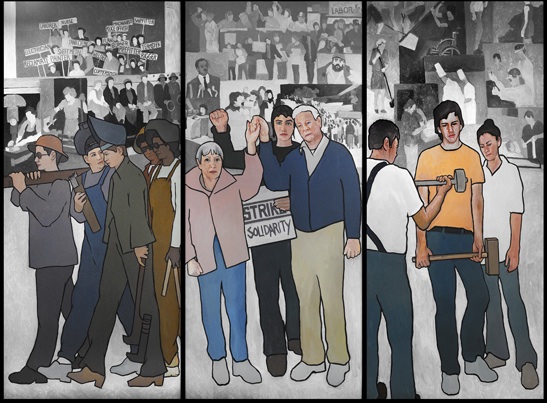BOSTON — Judges in a case challenging Gov. Paul LePage’s removal of a mural depicting scenes in Maine labor history pressed the plaintiffs’ attorney Monday on his central argument: that the mural represents the opinion of the artist, not the government that commissioned it.
The plaintiffs — two union officials and three artists — sued LePage and other state officials over the removal of the mural from the Maine Department of Labor’s headquarters in March 2011, arguing that it infringed on their First Amendment right to view the work.
The plaintiffs want the U.S. 1st Circuit Court of Appeals to send the case back to U.S. District Court in Bangor for a jury trial.
They argue that Chief U.S. District Judge John Woodcock Jr. was wrong when he ruled in April that the mural was government speech rather than that of Judy Taylor, the artist. Taylor is not a party in the case.
During oral arguments before the appeals court Monday, Chief Judge Sandra Lynch noted that the 11-panel mural was neither part of the state’s public art program nor a private donation. She noted that the mural was purchased under a contract that gave the artist limited rights related to the work.
“This isn’t even private speech being offered to them. This is something that they bought and paid for,” Lynch said during the presentation by Jeffrey Neil Young, the plaintiffs’ attorney.
The plaintiffs sued after LePage had the mural removed from the reception area of the labor department’s headquarters in Augusta in response to a complaint that it had a pro-labor message and was comparable to Communist propaganda in North Korea.
Several hundred people protested at the building after learning that LePage planned to remove the mural, which was taken down over a weekend. LePage’s administration has refused to say where it was moved.
Young said it’s wrong to assume that, just because a work is displayed in a government building, it is government speech.
“The state cannot discriminate on the basis of viewpoint,” he said after the proceeding. “That’s what’s happening here.”
In support of their argument, the plaintiffs contend that the government did not effectively control the message of the artwork. They note, among other things, that the committee that selected Taylor instructed her on the subject matter but not the message, and that her contract confirmed her independence in its creation.
Taylor was directed to create a work that emphasized the “value and dignity of workers and their critical role in creating the wealth of the state and nation.”
The plaintiffs say Taylor was selected for her technical skills and a style similar to that of artists who worked for the Works Progress Administration, the Depression-era federal effort that was part of President Franklin D. Roosevelt’s New Deal.
The WPA commissioned works by artists to keep them employed, and employed workers for projects such as public buildings and roads.
Young argued that a reasonable and informed person could recognize that the mural represented Taylor’s speech, given the state’s long history of displaying private art in public spaces and a plaque that attributed the mural to Taylor. The plaque also indicates that the mural was commissioned for the Department of Labor.
Judge Michael Boudin said that, given the placement of the mural, it’s not certain that a viewer would not interpret the mural as government speech.
“Just to say they know the artist painted it doesn’t answer the question,” he said.
Maine Deputy Attorney General Paul Stern argued before the three-judge panel that the plaintiffs aren’t actually fighting for free speech.
“What they want is the speech they like to be there as long as possible,” Stern said. “To say the First Amendment requires the state of Maine — and the Department of Labor — to have this mural there forever is wrong.”
The mural, commissioned in 2008 during the administration of Gov. John Baldacci, depicts scenes from Maine labor history, including a shoe workers strike, child laborers and Rosie the Riveter. The project cost $60,000, primarily federal money.
Donald Berry, one of the plaintiffs, said a full-size replica of the mural travels around Maine and the scenes resonate with viewers.
“We want them to be seen,” said Berry, president of the Maine AFL-CIO. “No question about it, they tell a great story.”
The judges did not indicate when they would issue a decision.
Staff Writer Ann S. Kim can be contacted at 791-6383 or at:
akim@pressherald.com
Send questions/comments to the editors.


